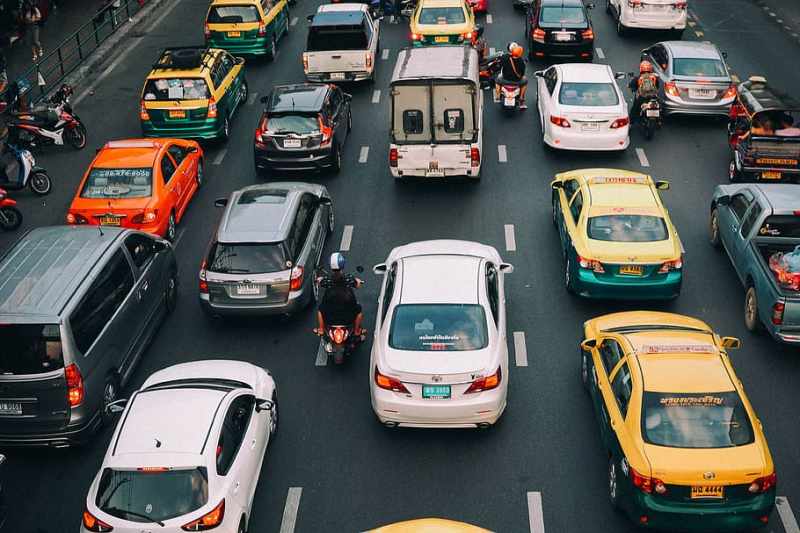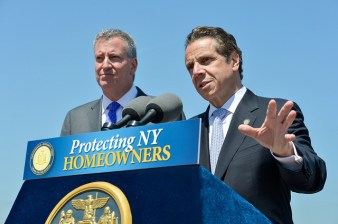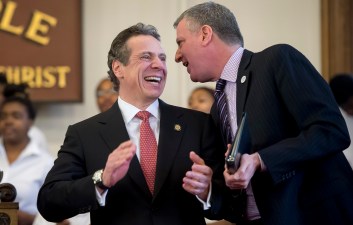Improv Everything: What Is The Plan To Move People as the Economy Reopens?

On June 8, New York City will begin the slow process of restarting its economy, sending a fraction of its private workforce back to their jobs. Is the city or the MTA ready to get them there? We hope you took some UCB improv classes.
On Friday, Mayor de Blasio and Gov. Cuomo answered the question with a collective shrug, a rare show of unity for the two men who have famously feuded over everything from the taxing the rich to dealing with a terrified deer.
De Blasio cemented his plan as being “no plan” at his morning news conference on Friday morning and then emphasized that during a later radio appearance. First, the mayor told reporters that it’s not possible right now to help New Yorkers with their transportation needs, but said he believed in their ability to make it work.
“People are going to have to improvise, and I believe they will,” de Blasio said when he was asked how an estimated 200,000 to 400,000 returning workers will get around.
Later, on WNYC’s “Brian Lehrer Show,” the mayor continued to be de blaséo about the city’s responsibility to avoid total gridlock, since that concern doesn’t exist in the real world.
“I’m in a real world place, Brian. I think we’re nowhere near the number of people on the road or the number of people in the subways that we normally would have. Even if everyone uses their car, it’s not in the next few months going to create the kind of congestion we’re used to by any stretch. So, I want people to feel comfortable with mass transit, but I know a certain number of people are going to use their car. For the next few months, we’re going to get by with that,” the mayor told the talk show host.
Later on Friday, Gov. Cuomo was asked about the mayor’s improv comment. The car-loving governor, famously photographed driving a Dodge Charger in Wall Street’s pedestrian-only road last week, said we all have choices to make and left it at that.
https://twitter.com/davidgura/status/1265275655035465729
“It’s up to you,” he said, when asked about the mayor’s comment. “You want to drive, you can drive. … Individuals make their own choices. I’m a Queens boy. I always had the choice to take the train or take the car.”
The question of how people will get to their jobs has gripped the city for weeks as disease indicators have headed in the correct direction, but few specifics have been offered about how those 200,000 to 400,000 people in the Phase I industries — construction, manufacturing, wholesale and and retail — will get around.
Even without an official “Everyone go back to work” siren going off, we know that more New Yorkers are moving around the city in late May than in early March. Over 600,000 people rode the subway every weekday from May 18 to May 29, after two consecutive weeks of daily weekday ridership rising above 500,000 riders per day for the first time in two months. However, people are also returning to their cars in greater numbers.
On March 30, one week into the state’s shelter-in-place order, city drivers racked up a total of 21,630,000 vehicle miles traveled according to data on Streetlight/Cuebiq, By May 26, that number was 41,790,000 VMT, a whopping 93-percent increase. Although this is still below the total 120,300,000 VMT on a normal city day, driving is outpacing other forms of travel recovery.
For now, here’s a look ahead at how things stand for cyclists, train riders and bus riders.
Bikes
The city has installed emergency bike lanes in Downtown Brooklyn, Crown Heights, Park Slope, Fort Greene, Astoria, Midtown Manhattan and the Financial District. Some of the bike lanes kind of work. Others are complete failures. The de Blasio administration has not gone out of its way to make biking to work any easier, declining to install long-requested fixes like giving cyclists and pedestrians more room on the over-crowded, car-light Queensboro Bridge. The MTA has also failed to legalize cycling on any of its bridges, even as the agency has asked people to stay off of trains and buses while they can.
City data show that cycling is surging, especially on weekends. If many of those new cyclists become regular bike commuters, there will likely be lots more injuries and fatalities as cars return … if the mayor doesn’t make the roadways safe.
Buses
Bus ridership has actually outpaced train ridership during the pandemic, with around 700,000 riders per day by the end of May. The de Blasio administration has cut money from its own Better Buses Initiative in response to the massive budget shortfalls that have hit the city, but the cut has not gone over well with other city leaders. Last week, the city’s four elected borough presidents (Queens does not have a real Beep right now) demanded 40 miles of bus lanes around New York in order to keep space clear for bus riders as the city begins to reopen.
A coalition of transit agencies made the same ask on the same day.
Manhattan Borough President Gale Brewer blasted the mayor’s suggestion that people can improvise their commutes as the kind of attitude that will allow “the wealthy insulate themselves from transit mismanagement” while poorer bus riders are stuck in traffic.
Leaving people to 'improvise' will mean the wealthy insulate themselves from transit mismanagement by driving while the poor get stuck on traffic-clogged buses. We need a plan and that starts with 40 miles of bus lanes citywide: https://t.co/tWEU1anbRR https://t.co/FrXvXoKd98
— Gale A. Brewer (@galeabrewer) May 29, 2020
Mayor de Blasio told Lehrer “we’re not getting enough clarity” from the MTA when he was asked about bus ridership and the transit agency’s plans for moving New Yorkers around, which drew a caustic response from New York City Transit President Sarah Feinberg, who tweeted that she “no idea what the mayor is talking about.”
https://twitter.com/FeinbergSarah/status/1266387839589244929
Trains
The subway has been seen as a particularly egregious coronavirus vector, although the science is hardly definitive. In Japan, for instance, researchers didn’t find any coronavirus clusters emanating from commuter trains, which they attributed to the fact that commuters wore masks and don’t speak to each other (hey, New Yorkers are great at that!). MTA officials are still formulating their plan on how to keep the subways safe as more New Yorkers return to it, with safety measures mostly centered around mandatory mask-wearing in subway stations.
MTA Board member and Cuomo budget director Rob Mujica told reporters on Friday that the agency is running at about 80 percent of normal service right now, and that the service will increase as ridership returns during Phase I. The MTA has still not addressed when the subway will resume 24 hour service, which could mean returning construction workers on early-morning shifts will need to be accommodated by the MTA’s Essential Service buses between 1 a.m. and 5 a.m.
The federal response to commuting and the pandemic does not look encouraging for New York City, either. The Centers for Disease Control took the extraordinary step of recommending that commuters drive instead of taking public transit. If that advice was followed in this city, the gridlock would paralyze the city. The MTA, for its part, pushed back with a statement from Chairman and CEO Pat Foye on Friday in which he called the federal guidance “confounding”:
The CDC’s latest guidance marks yet another confounding recommendation from the nation’s top public health authority. Encouraging people, especially those without cars and in congested areas like New York, not to take public transit is misguided. Transit is, and has long been, the safest way to move around any city. Our transit and bus system is cleaner and safer than it has been in history, as we clean and disinfect around the clock. Everyone who rides the MTA is required to wear a mask, a uniform policy we adopted for our workforce before the CDC reversed its previous guideline and recommended all Americans wear masks. We will continue to take every possible action to protect public health and safety, and the federal government telling people not to ride mass transit sets us back decades.
Foye also wrote what he called an “open letter to New York’s business community” in which he urged “key employers in the city” to institute a plan to stagger work hours in order to keep trains and buses from being overwhelmed.
The New York Stock Exchange has been highest-profile business to welcome some employees back, but explicitly barred them from taking public transportation to get to work, although the traders themselves have not been fans of NYSE’s plan. It’s yet to be seen whether other employers follow suit, or what the city’s conversations with employers has been as far as staggering office hours to ensure trains running during traditional rush hours are not packed cheek-t0-cheek.

